Starbucks' Marketing Plan: Strategy for New Product Introduction
VerifiedAdded on 2023/06/04
|21
|4283
|269
Report
AI Summary
This report provides a detailed marketing plan for Starbucks, focusing on the introduction of new products. It identifies key target market segments based on demographic, psychographic, and geographic factors, and proposes an ideal positioning strategy to enhance product sales. The plan includes a positioning statement and map to guide Starbucks' efforts. A comprehensive marketing mix strategy is outlined, covering product attributes, pricing, promotion, and distribution. Furthermore, the report presents an evaluation and control plan with specific metrics, followed by an implementation plan featuring a Gantt chart for a one-year schedule. The report concludes with recommendations for Starbucks' future strategic initiatives. Desklib offers a wide range of study resources, including past papers and solved assignments, to support students in their academic endeavors.
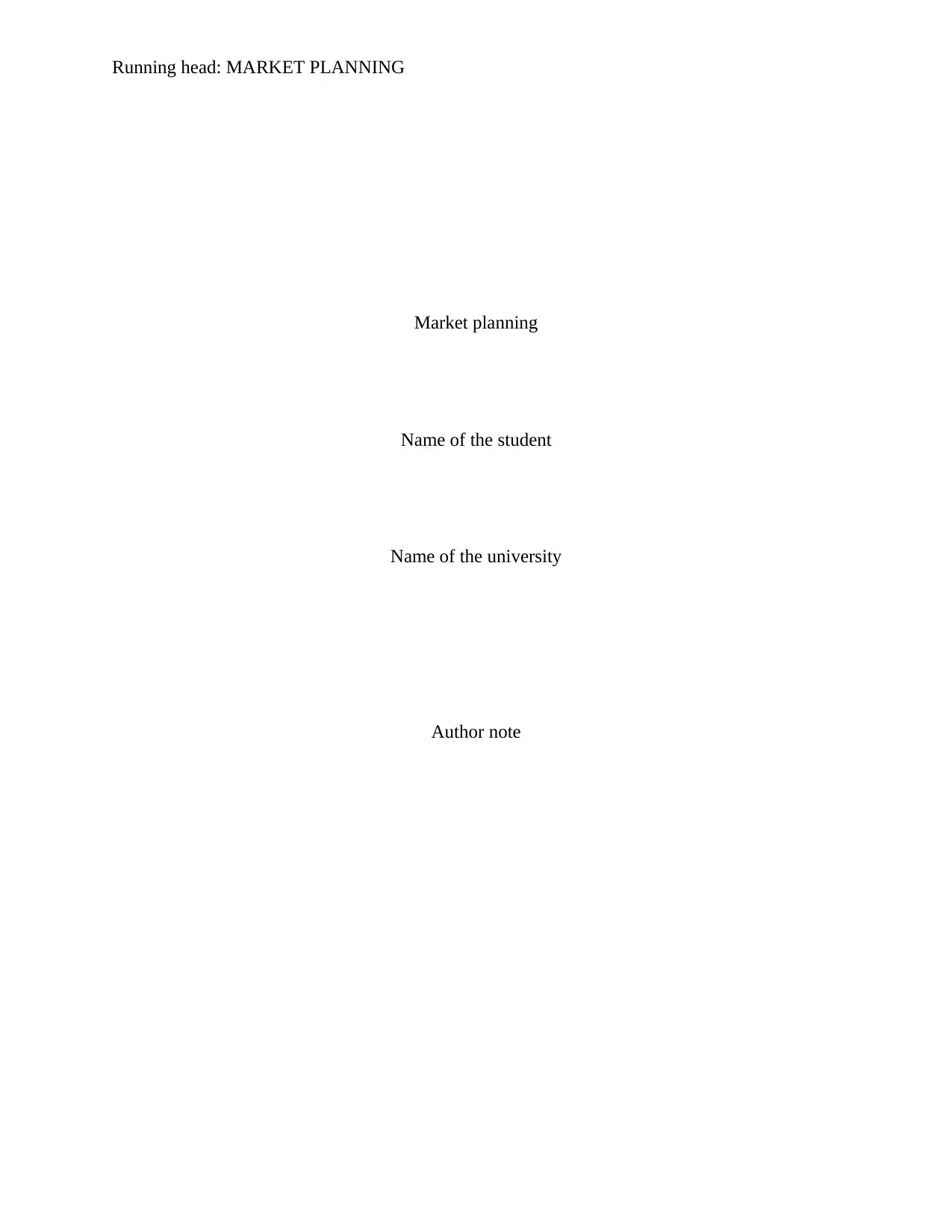
Running head: MARKET PLANNING
Market planning
Name of the student
Name of the university
Author note
Market planning
Name of the student
Name of the university
Author note
Paraphrase This Document
Need a fresh take? Get an instant paraphrase of this document with our AI Paraphraser
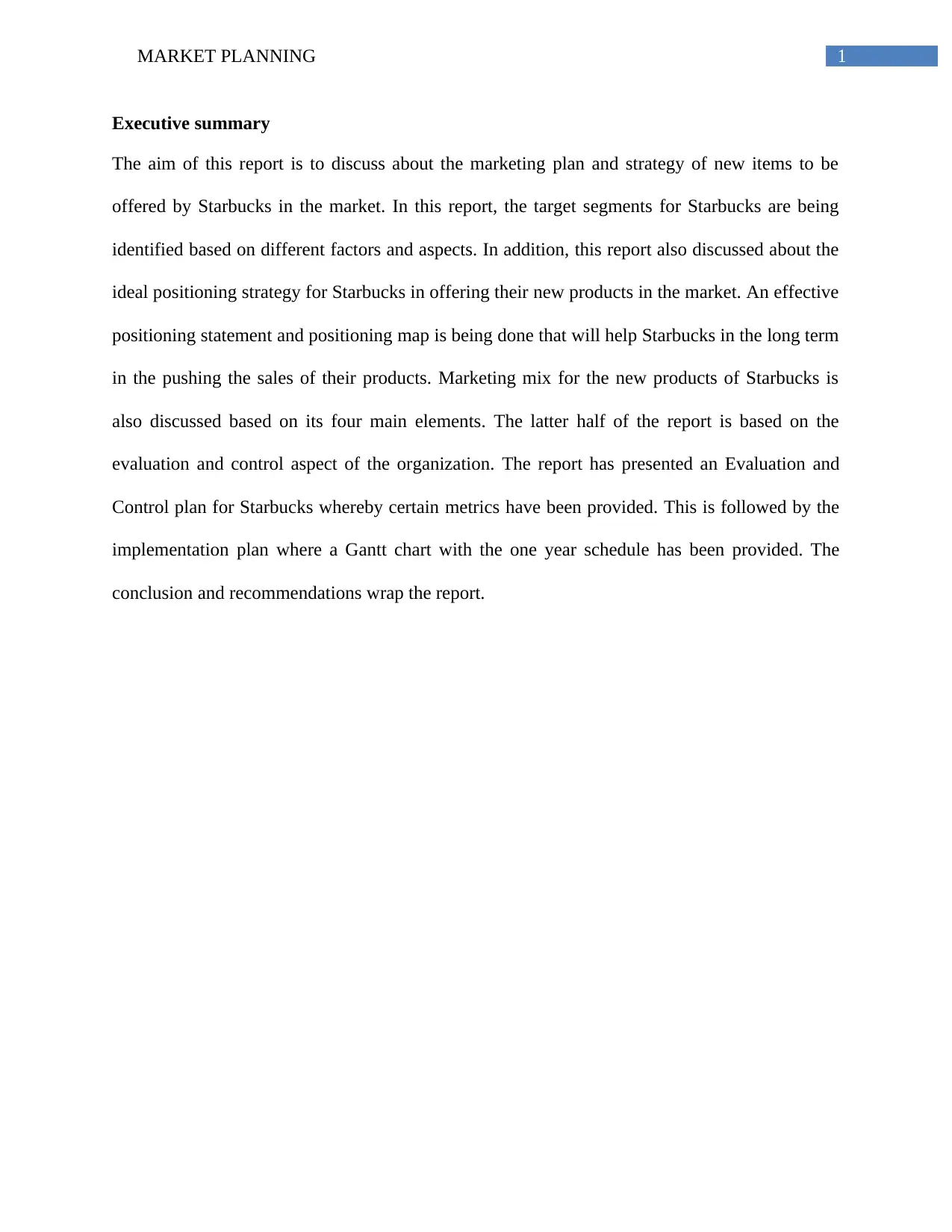
1MARKET PLANNING
Executive summary
The aim of this report is to discuss about the marketing plan and strategy of new items to be
offered by Starbucks in the market. In this report, the target segments for Starbucks are being
identified based on different factors and aspects. In addition, this report also discussed about the
ideal positioning strategy for Starbucks in offering their new products in the market. An effective
positioning statement and positioning map is being done that will help Starbucks in the long term
in the pushing the sales of their products. Marketing mix for the new products of Starbucks is
also discussed based on its four main elements. The latter half of the report is based on the
evaluation and control aspect of the organization. The report has presented an Evaluation and
Control plan for Starbucks whereby certain metrics have been provided. This is followed by the
implementation plan where a Gantt chart with the one year schedule has been provided. The
conclusion and recommendations wrap the report.
Executive summary
The aim of this report is to discuss about the marketing plan and strategy of new items to be
offered by Starbucks in the market. In this report, the target segments for Starbucks are being
identified based on different factors and aspects. In addition, this report also discussed about the
ideal positioning strategy for Starbucks in offering their new products in the market. An effective
positioning statement and positioning map is being done that will help Starbucks in the long term
in the pushing the sales of their products. Marketing mix for the new products of Starbucks is
also discussed based on its four main elements. The latter half of the report is based on the
evaluation and control aspect of the organization. The report has presented an Evaluation and
Control plan for Starbucks whereby certain metrics have been provided. This is followed by the
implementation plan where a Gantt chart with the one year schedule has been provided. The
conclusion and recommendations wrap the report.
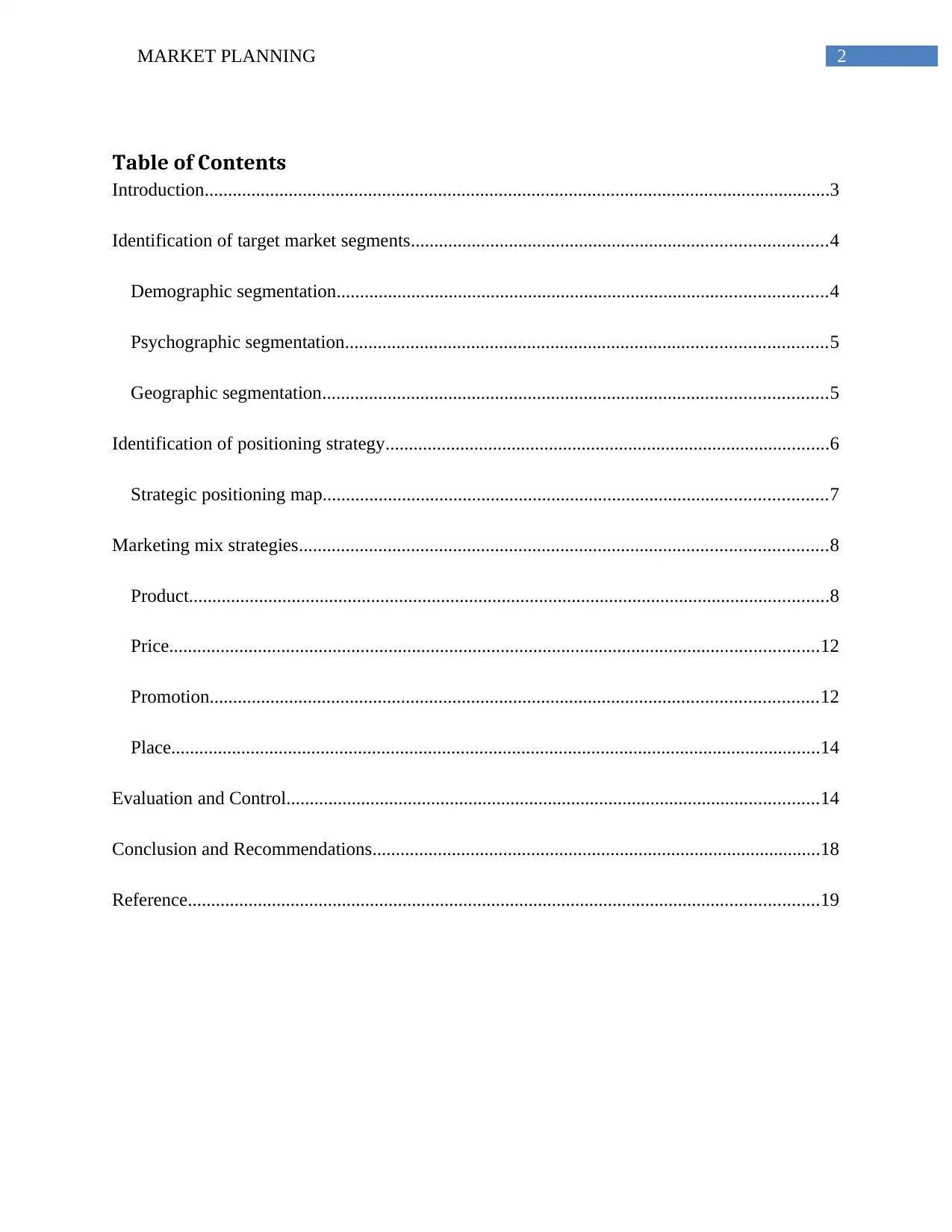
2MARKET PLANNING
Table of Contents
Introduction......................................................................................................................................3
Identification of target market segments.........................................................................................4
Demographic segmentation.........................................................................................................4
Psychographic segmentation.......................................................................................................5
Geographic segmentation............................................................................................................5
Identification of positioning strategy...............................................................................................6
Strategic positioning map............................................................................................................7
Marketing mix strategies.................................................................................................................8
Product.........................................................................................................................................8
Price...........................................................................................................................................12
Promotion..................................................................................................................................12
Place...........................................................................................................................................14
Evaluation and Control..................................................................................................................14
Conclusion and Recommendations................................................................................................18
Reference.......................................................................................................................................19
Table of Contents
Introduction......................................................................................................................................3
Identification of target market segments.........................................................................................4
Demographic segmentation.........................................................................................................4
Psychographic segmentation.......................................................................................................5
Geographic segmentation............................................................................................................5
Identification of positioning strategy...............................................................................................6
Strategic positioning map............................................................................................................7
Marketing mix strategies.................................................................................................................8
Product.........................................................................................................................................8
Price...........................................................................................................................................12
Promotion..................................................................................................................................12
Place...........................................................................................................................................14
Evaluation and Control..................................................................................................................14
Conclusion and Recommendations................................................................................................18
Reference.......................................................................................................................................19
⊘ This is a preview!⊘
Do you want full access?
Subscribe today to unlock all pages.

Trusted by 1+ million students worldwide
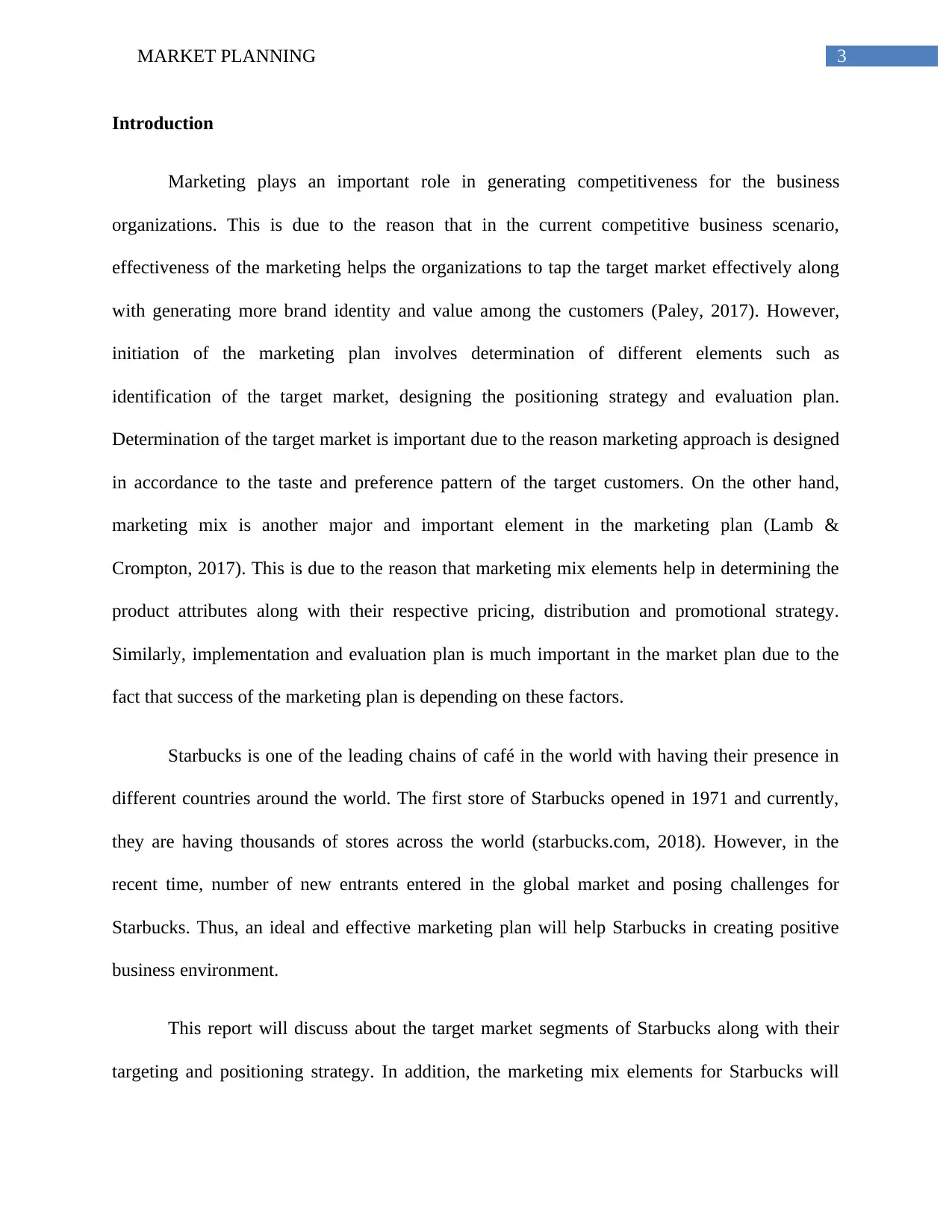
3MARKET PLANNING
Introduction
Marketing plays an important role in generating competitiveness for the business
organizations. This is due to the reason that in the current competitive business scenario,
effectiveness of the marketing helps the organizations to tap the target market effectively along
with generating more brand identity and value among the customers (Paley, 2017). However,
initiation of the marketing plan involves determination of different elements such as
identification of the target market, designing the positioning strategy and evaluation plan.
Determination of the target market is important due to the reason marketing approach is designed
in accordance to the taste and preference pattern of the target customers. On the other hand,
marketing mix is another major and important element in the marketing plan (Lamb &
Crompton, 2017). This is due to the reason that marketing mix elements help in determining the
product attributes along with their respective pricing, distribution and promotional strategy.
Similarly, implementation and evaluation plan is much important in the market plan due to the
fact that success of the marketing plan is depending on these factors.
Starbucks is one of the leading chains of café in the world with having their presence in
different countries around the world. The first store of Starbucks opened in 1971 and currently,
they are having thousands of stores across the world (starbucks.com, 2018). However, in the
recent time, number of new entrants entered in the global market and posing challenges for
Starbucks. Thus, an ideal and effective marketing plan will help Starbucks in creating positive
business environment.
This report will discuss about the target market segments of Starbucks along with their
targeting and positioning strategy. In addition, the marketing mix elements for Starbucks will
Introduction
Marketing plays an important role in generating competitiveness for the business
organizations. This is due to the reason that in the current competitive business scenario,
effectiveness of the marketing helps the organizations to tap the target market effectively along
with generating more brand identity and value among the customers (Paley, 2017). However,
initiation of the marketing plan involves determination of different elements such as
identification of the target market, designing the positioning strategy and evaluation plan.
Determination of the target market is important due to the reason marketing approach is designed
in accordance to the taste and preference pattern of the target customers. On the other hand,
marketing mix is another major and important element in the marketing plan (Lamb &
Crompton, 2017). This is due to the reason that marketing mix elements help in determining the
product attributes along with their respective pricing, distribution and promotional strategy.
Similarly, implementation and evaluation plan is much important in the market plan due to the
fact that success of the marketing plan is depending on these factors.
Starbucks is one of the leading chains of café in the world with having their presence in
different countries around the world. The first store of Starbucks opened in 1971 and currently,
they are having thousands of stores across the world (starbucks.com, 2018). However, in the
recent time, number of new entrants entered in the global market and posing challenges for
Starbucks. Thus, an ideal and effective marketing plan will help Starbucks in creating positive
business environment.
This report will discuss about the target market segments of Starbucks along with their
targeting and positioning strategy. In addition, the marketing mix elements for Starbucks will
Paraphrase This Document
Need a fresh take? Get an instant paraphrase of this document with our AI Paraphraser
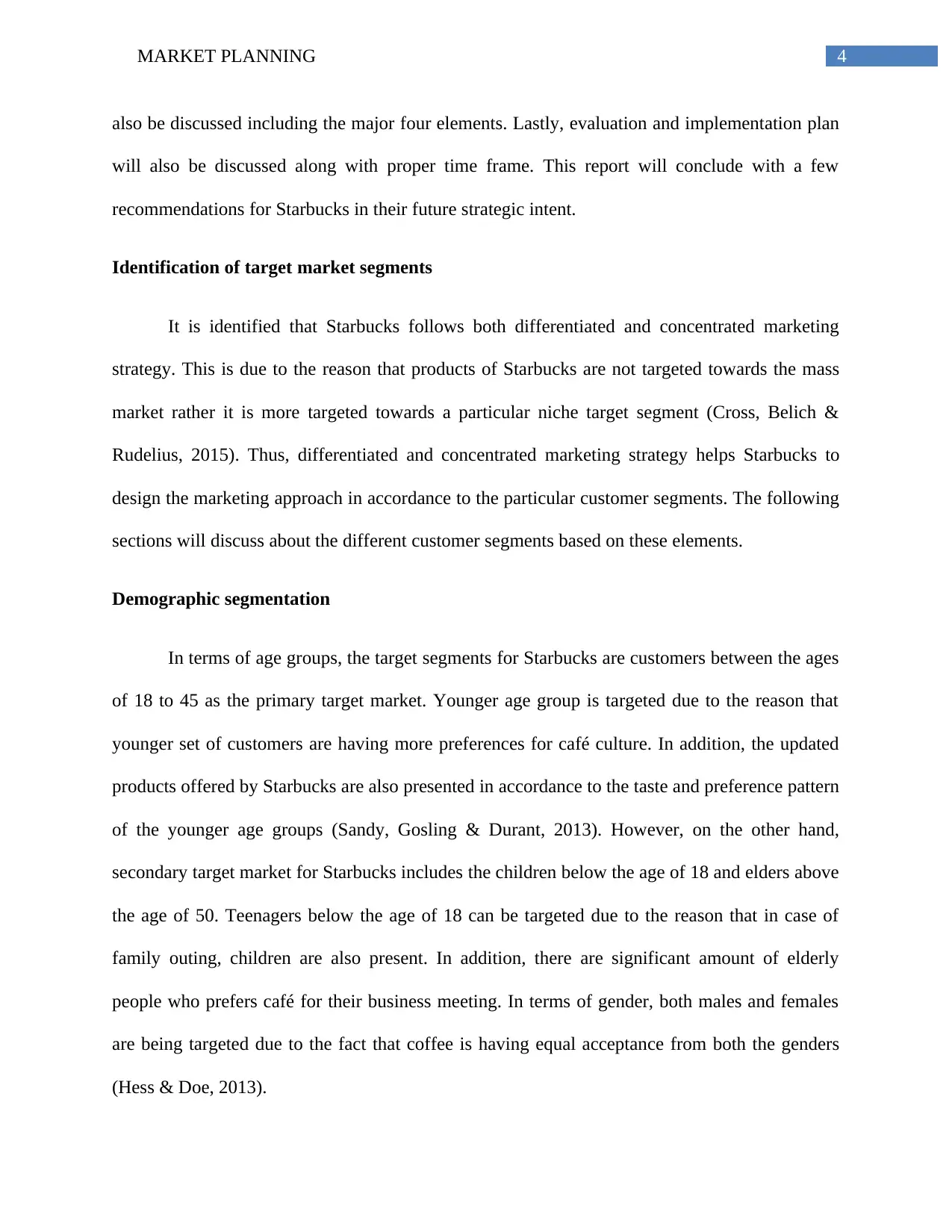
4MARKET PLANNING
also be discussed including the major four elements. Lastly, evaluation and implementation plan
will also be discussed along with proper time frame. This report will conclude with a few
recommendations for Starbucks in their future strategic intent.
Identification of target market segments
It is identified that Starbucks follows both differentiated and concentrated marketing
strategy. This is due to the reason that products of Starbucks are not targeted towards the mass
market rather it is more targeted towards a particular niche target segment (Cross, Belich &
Rudelius, 2015). Thus, differentiated and concentrated marketing strategy helps Starbucks to
design the marketing approach in accordance to the particular customer segments. The following
sections will discuss about the different customer segments based on these elements.
Demographic segmentation
In terms of age groups, the target segments for Starbucks are customers between the ages
of 18 to 45 as the primary target market. Younger age group is targeted due to the reason that
younger set of customers are having more preferences for café culture. In addition, the updated
products offered by Starbucks are also presented in accordance to the taste and preference pattern
of the younger age groups (Sandy, Gosling & Durant, 2013). However, on the other hand,
secondary target market for Starbucks includes the children below the age of 18 and elders above
the age of 50. Teenagers below the age of 18 can be targeted due to the reason that in case of
family outing, children are also present. In addition, there are significant amount of elderly
people who prefers café for their business meeting. In terms of gender, both males and females
are being targeted due to the fact that coffee is having equal acceptance from both the genders
(Hess & Doe, 2013).
also be discussed including the major four elements. Lastly, evaluation and implementation plan
will also be discussed along with proper time frame. This report will conclude with a few
recommendations for Starbucks in their future strategic intent.
Identification of target market segments
It is identified that Starbucks follows both differentiated and concentrated marketing
strategy. This is due to the reason that products of Starbucks are not targeted towards the mass
market rather it is more targeted towards a particular niche target segment (Cross, Belich &
Rudelius, 2015). Thus, differentiated and concentrated marketing strategy helps Starbucks to
design the marketing approach in accordance to the particular customer segments. The following
sections will discuss about the different customer segments based on these elements.
Demographic segmentation
In terms of age groups, the target segments for Starbucks are customers between the ages
of 18 to 45 as the primary target market. Younger age group is targeted due to the reason that
younger set of customers are having more preferences for café culture. In addition, the updated
products offered by Starbucks are also presented in accordance to the taste and preference pattern
of the younger age groups (Sandy, Gosling & Durant, 2013). However, on the other hand,
secondary target market for Starbucks includes the children below the age of 18 and elders above
the age of 50. Teenagers below the age of 18 can be targeted due to the reason that in case of
family outing, children are also present. In addition, there are significant amount of elderly
people who prefers café for their business meeting. In terms of gender, both males and females
are being targeted due to the fact that coffee is having equal acceptance from both the genders
(Hess & Doe, 2013).
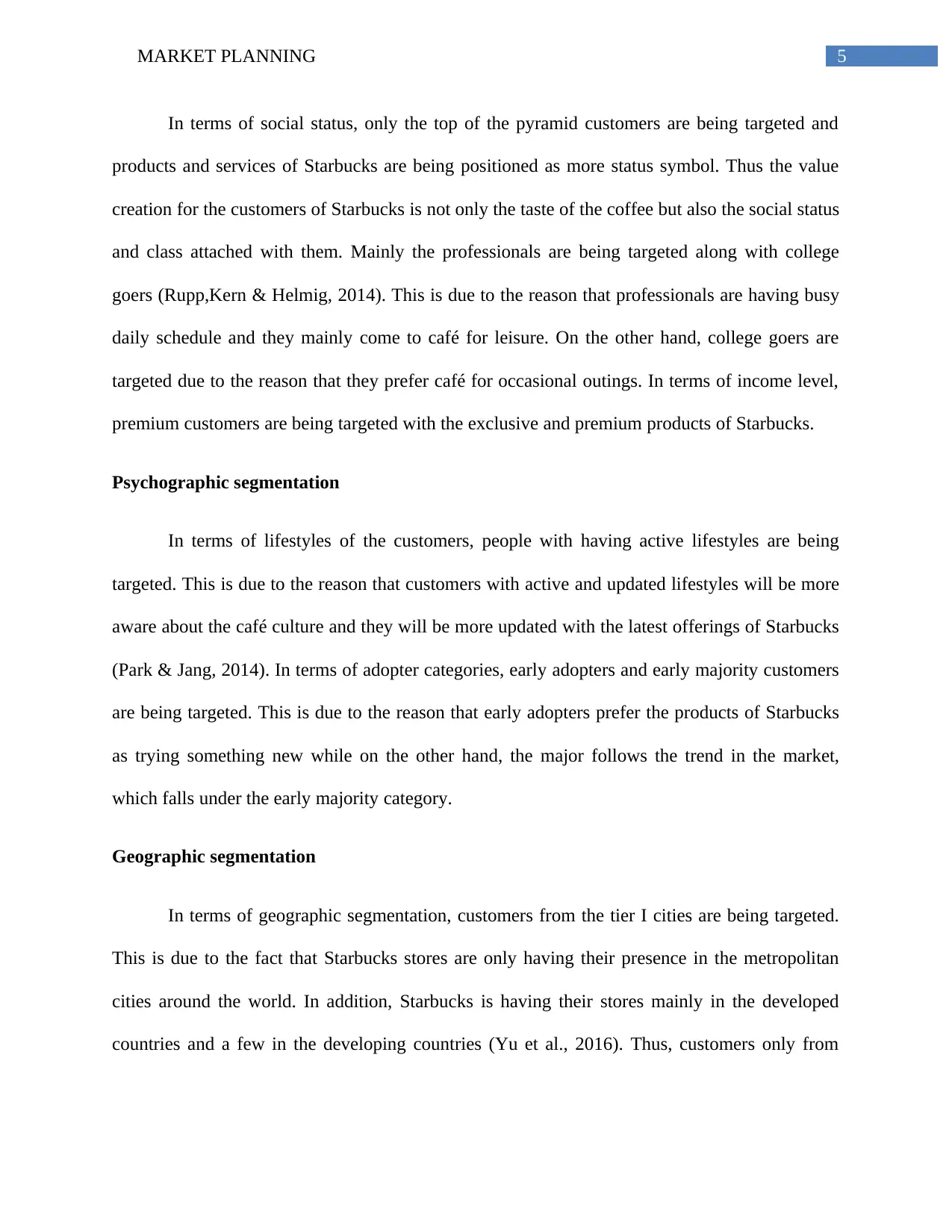
5MARKET PLANNING
In terms of social status, only the top of the pyramid customers are being targeted and
products and services of Starbucks are being positioned as more status symbol. Thus the value
creation for the customers of Starbucks is not only the taste of the coffee but also the social status
and class attached with them. Mainly the professionals are being targeted along with college
goers (Rupp,Kern & Helmig, 2014). This is due to the reason that professionals are having busy
daily schedule and they mainly come to café for leisure. On the other hand, college goers are
targeted due to the reason that they prefer café for occasional outings. In terms of income level,
premium customers are being targeted with the exclusive and premium products of Starbucks.
Psychographic segmentation
In terms of lifestyles of the customers, people with having active lifestyles are being
targeted. This is due to the reason that customers with active and updated lifestyles will be more
aware about the café culture and they will be more updated with the latest offerings of Starbucks
(Park & Jang, 2014). In terms of adopter categories, early adopters and early majority customers
are being targeted. This is due to the reason that early adopters prefer the products of Starbucks
as trying something new while on the other hand, the major follows the trend in the market,
which falls under the early majority category.
Geographic segmentation
In terms of geographic segmentation, customers from the tier I cities are being targeted.
This is due to the fact that Starbucks stores are only having their presence in the metropolitan
cities around the world. In addition, Starbucks is having their stores mainly in the developed
countries and a few in the developing countries (Yu et al., 2016). Thus, customers only from
In terms of social status, only the top of the pyramid customers are being targeted and
products and services of Starbucks are being positioned as more status symbol. Thus the value
creation for the customers of Starbucks is not only the taste of the coffee but also the social status
and class attached with them. Mainly the professionals are being targeted along with college
goers (Rupp,Kern & Helmig, 2014). This is due to the reason that professionals are having busy
daily schedule and they mainly come to café for leisure. On the other hand, college goers are
targeted due to the reason that they prefer café for occasional outings. In terms of income level,
premium customers are being targeted with the exclusive and premium products of Starbucks.
Psychographic segmentation
In terms of lifestyles of the customers, people with having active lifestyles are being
targeted. This is due to the reason that customers with active and updated lifestyles will be more
aware about the café culture and they will be more updated with the latest offerings of Starbucks
(Park & Jang, 2014). In terms of adopter categories, early adopters and early majority customers
are being targeted. This is due to the reason that early adopters prefer the products of Starbucks
as trying something new while on the other hand, the major follows the trend in the market,
which falls under the early majority category.
Geographic segmentation
In terms of geographic segmentation, customers from the tier I cities are being targeted.
This is due to the fact that Starbucks stores are only having their presence in the metropolitan
cities around the world. In addition, Starbucks is having their stores mainly in the developed
countries and a few in the developing countries (Yu et al., 2016). Thus, customers only from
⊘ This is a preview!⊘
Do you want full access?
Subscribe today to unlock all pages.

Trusted by 1+ million students worldwide
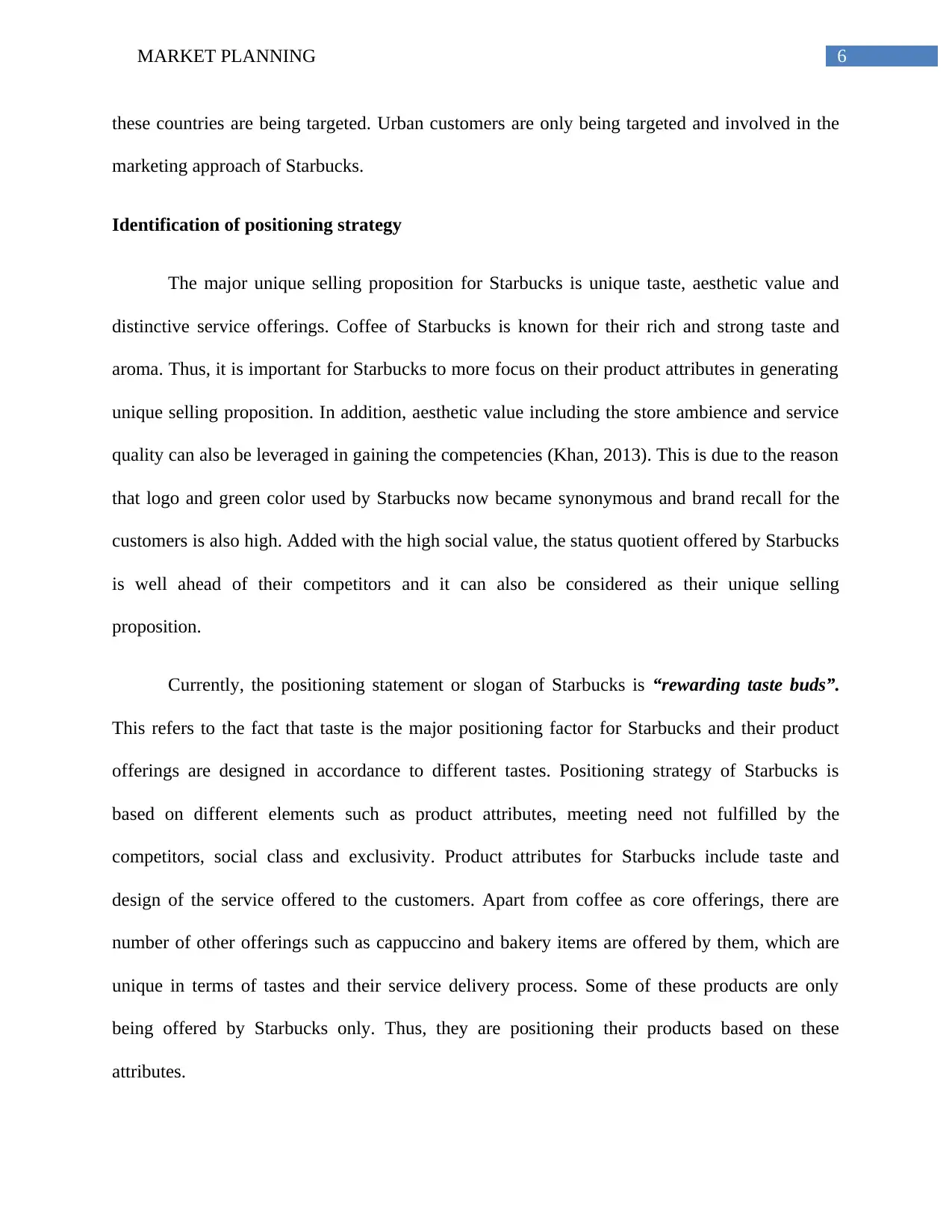
6MARKET PLANNING
these countries are being targeted. Urban customers are only being targeted and involved in the
marketing approach of Starbucks.
Identification of positioning strategy
The major unique selling proposition for Starbucks is unique taste, aesthetic value and
distinctive service offerings. Coffee of Starbucks is known for their rich and strong taste and
aroma. Thus, it is important for Starbucks to more focus on their product attributes in generating
unique selling proposition. In addition, aesthetic value including the store ambience and service
quality can also be leveraged in gaining the competencies (Khan, 2013). This is due to the reason
that logo and green color used by Starbucks now became synonymous and brand recall for the
customers is also high. Added with the high social value, the status quotient offered by Starbucks
is well ahead of their competitors and it can also be considered as their unique selling
proposition.
Currently, the positioning statement or slogan of Starbucks is “rewarding taste buds”.
This refers to the fact that taste is the major positioning factor for Starbucks and their product
offerings are designed in accordance to different tastes. Positioning strategy of Starbucks is
based on different elements such as product attributes, meeting need not fulfilled by the
competitors, social class and exclusivity. Product attributes for Starbucks include taste and
design of the service offered to the customers. Apart from coffee as core offerings, there are
number of other offerings such as cappuccino and bakery items are offered by them, which are
unique in terms of tastes and their service delivery process. Some of these products are only
being offered by Starbucks only. Thus, they are positioning their products based on these
attributes.
these countries are being targeted. Urban customers are only being targeted and involved in the
marketing approach of Starbucks.
Identification of positioning strategy
The major unique selling proposition for Starbucks is unique taste, aesthetic value and
distinctive service offerings. Coffee of Starbucks is known for their rich and strong taste and
aroma. Thus, it is important for Starbucks to more focus on their product attributes in generating
unique selling proposition. In addition, aesthetic value including the store ambience and service
quality can also be leveraged in gaining the competencies (Khan, 2013). This is due to the reason
that logo and green color used by Starbucks now became synonymous and brand recall for the
customers is also high. Added with the high social value, the status quotient offered by Starbucks
is well ahead of their competitors and it can also be considered as their unique selling
proposition.
Currently, the positioning statement or slogan of Starbucks is “rewarding taste buds”.
This refers to the fact that taste is the major positioning factor for Starbucks and their product
offerings are designed in accordance to different tastes. Positioning strategy of Starbucks is
based on different elements such as product attributes, meeting need not fulfilled by the
competitors, social class and exclusivity. Product attributes for Starbucks include taste and
design of the service offered to the customers. Apart from coffee as core offerings, there are
number of other offerings such as cappuccino and bakery items are offered by them, which are
unique in terms of tastes and their service delivery process. Some of these products are only
being offered by Starbucks only. Thus, they are positioning their products based on these
attributes.
Paraphrase This Document
Need a fresh take? Get an instant paraphrase of this document with our AI Paraphraser
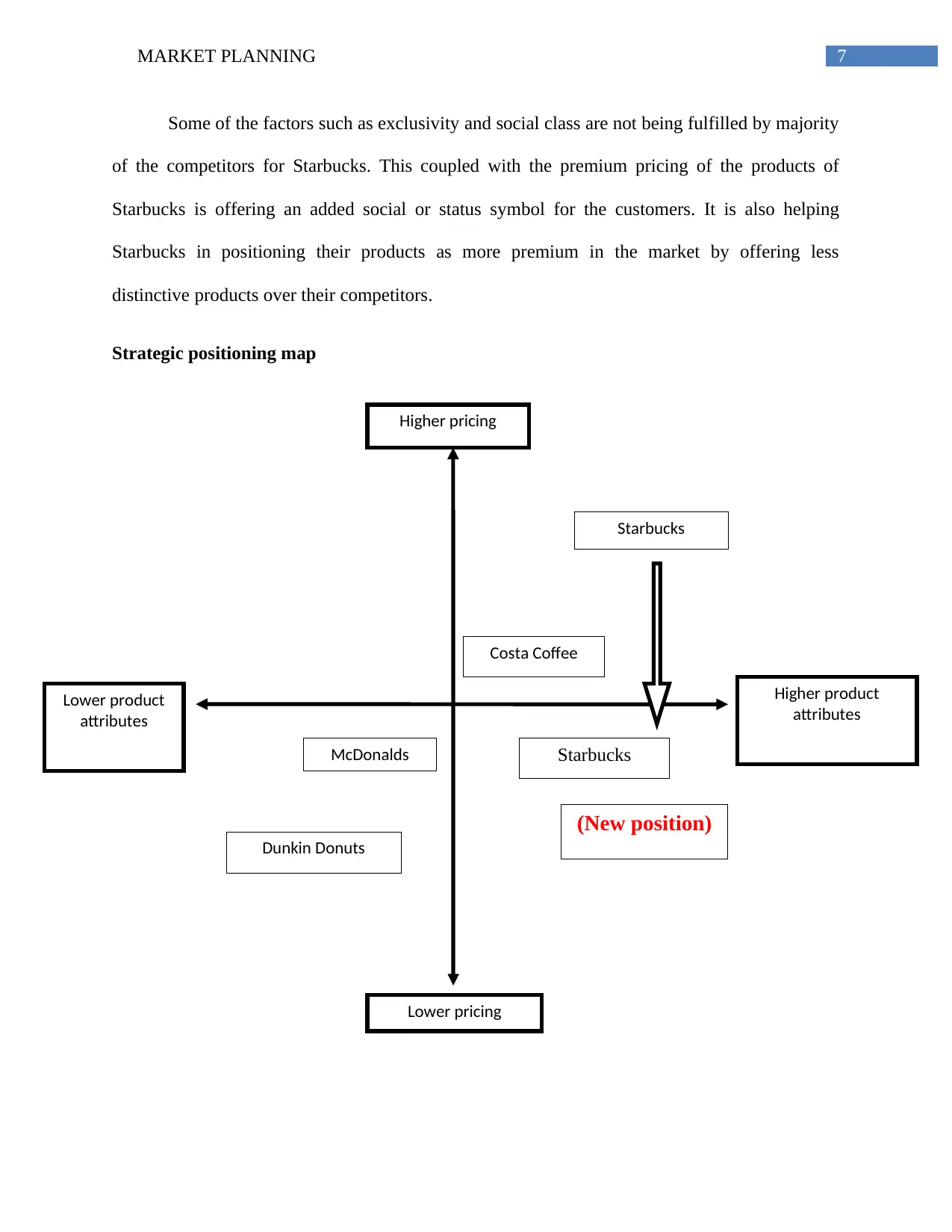
7MARKET PLANNING
Higher pricing
Lower pricing
Higher product
attributes
Lower product
attributes
Starbucks
McDonalds
Costa Coffee
Dunkin Donuts
Starbucks
(New position)
Some of the factors such as exclusivity and social class are not being fulfilled by majority
of the competitors for Starbucks. This coupled with the premium pricing of the products of
Starbucks is offering an added social or status symbol for the customers. It is also helping
Starbucks in positioning their products as more premium in the market by offering less
distinctive products over their competitors.
Strategic positioning map
Higher pricing
Lower pricing
Higher product
attributes
Lower product
attributes
Starbucks
McDonalds
Costa Coffee
Dunkin Donuts
Starbucks
(New position)
Some of the factors such as exclusivity and social class are not being fulfilled by majority
of the competitors for Starbucks. This coupled with the premium pricing of the products of
Starbucks is offering an added social or status symbol for the customers. It is also helping
Starbucks in positioning their products as more premium in the market by offering less
distinctive products over their competitors.
Strategic positioning map
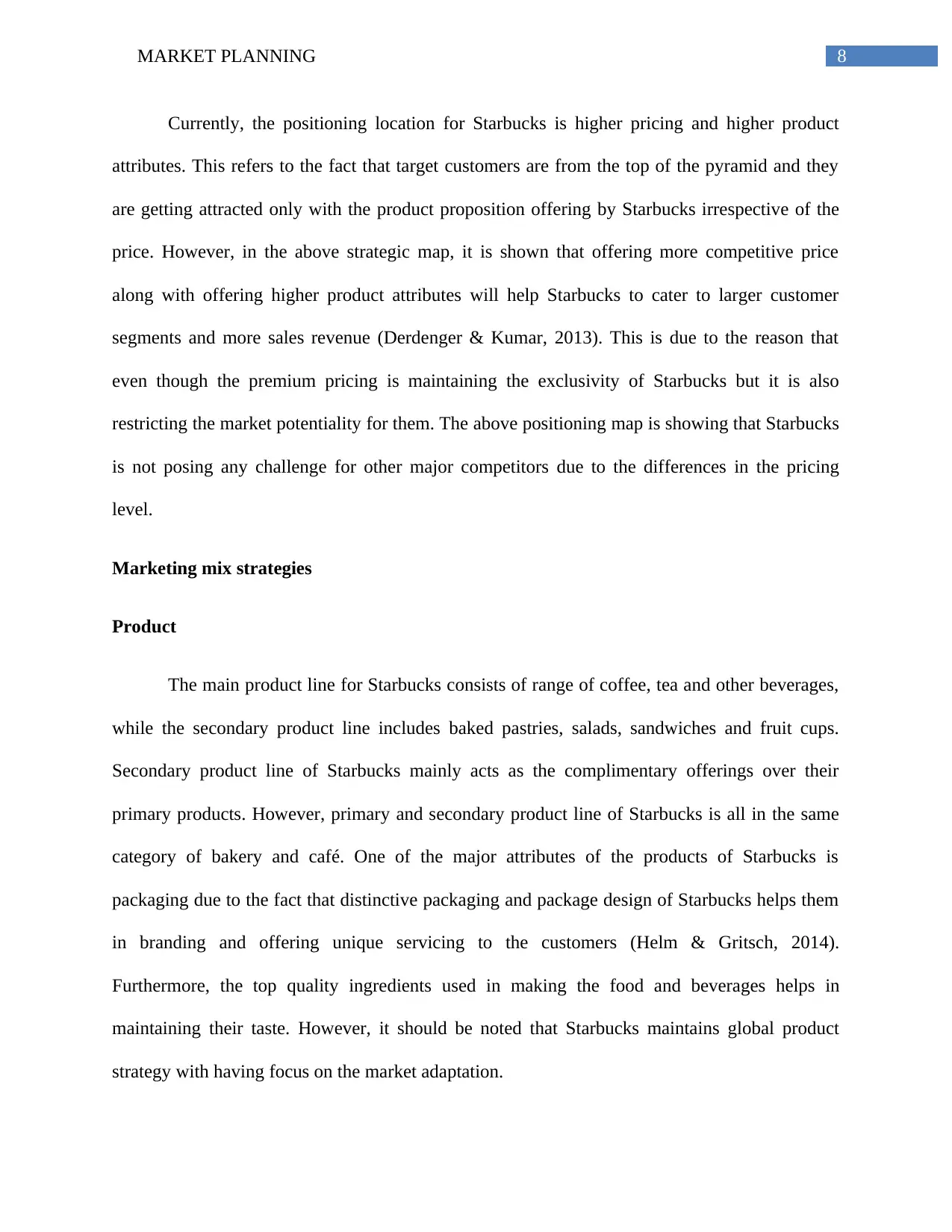
8MARKET PLANNING
Currently, the positioning location for Starbucks is higher pricing and higher product
attributes. This refers to the fact that target customers are from the top of the pyramid and they
are getting attracted only with the product proposition offering by Starbucks irrespective of the
price. However, in the above strategic map, it is shown that offering more competitive price
along with offering higher product attributes will help Starbucks to cater to larger customer
segments and more sales revenue (Derdenger & Kumar, 2013). This is due to the reason that
even though the premium pricing is maintaining the exclusivity of Starbucks but it is also
restricting the market potentiality for them. The above positioning map is showing that Starbucks
is not posing any challenge for other major competitors due to the differences in the pricing
level.
Marketing mix strategies
Product
The main product line for Starbucks consists of range of coffee, tea and other beverages,
while the secondary product line includes baked pastries, salads, sandwiches and fruit cups.
Secondary product line of Starbucks mainly acts as the complimentary offerings over their
primary products. However, primary and secondary product line of Starbucks is all in the same
category of bakery and café. One of the major attributes of the products of Starbucks is
packaging due to the fact that distinctive packaging and package design of Starbucks helps them
in branding and offering unique servicing to the customers (Helm & Gritsch, 2014).
Furthermore, the top quality ingredients used in making the food and beverages helps in
maintaining their taste. However, it should be noted that Starbucks maintains global product
strategy with having focus on the market adaptation.
Currently, the positioning location for Starbucks is higher pricing and higher product
attributes. This refers to the fact that target customers are from the top of the pyramid and they
are getting attracted only with the product proposition offering by Starbucks irrespective of the
price. However, in the above strategic map, it is shown that offering more competitive price
along with offering higher product attributes will help Starbucks to cater to larger customer
segments and more sales revenue (Derdenger & Kumar, 2013). This is due to the reason that
even though the premium pricing is maintaining the exclusivity of Starbucks but it is also
restricting the market potentiality for them. The above positioning map is showing that Starbucks
is not posing any challenge for other major competitors due to the differences in the pricing
level.
Marketing mix strategies
Product
The main product line for Starbucks consists of range of coffee, tea and other beverages,
while the secondary product line includes baked pastries, salads, sandwiches and fruit cups.
Secondary product line of Starbucks mainly acts as the complimentary offerings over their
primary products. However, primary and secondary product line of Starbucks is all in the same
category of bakery and café. One of the major attributes of the products of Starbucks is
packaging due to the fact that distinctive packaging and package design of Starbucks helps them
in branding and offering unique servicing to the customers (Helm & Gritsch, 2014).
Furthermore, the top quality ingredients used in making the food and beverages helps in
maintaining their taste. However, it should be noted that Starbucks maintains global product
strategy with having focus on the market adaptation.
⊘ This is a preview!⊘
Do you want full access?
Subscribe today to unlock all pages.

Trusted by 1+ million students worldwide
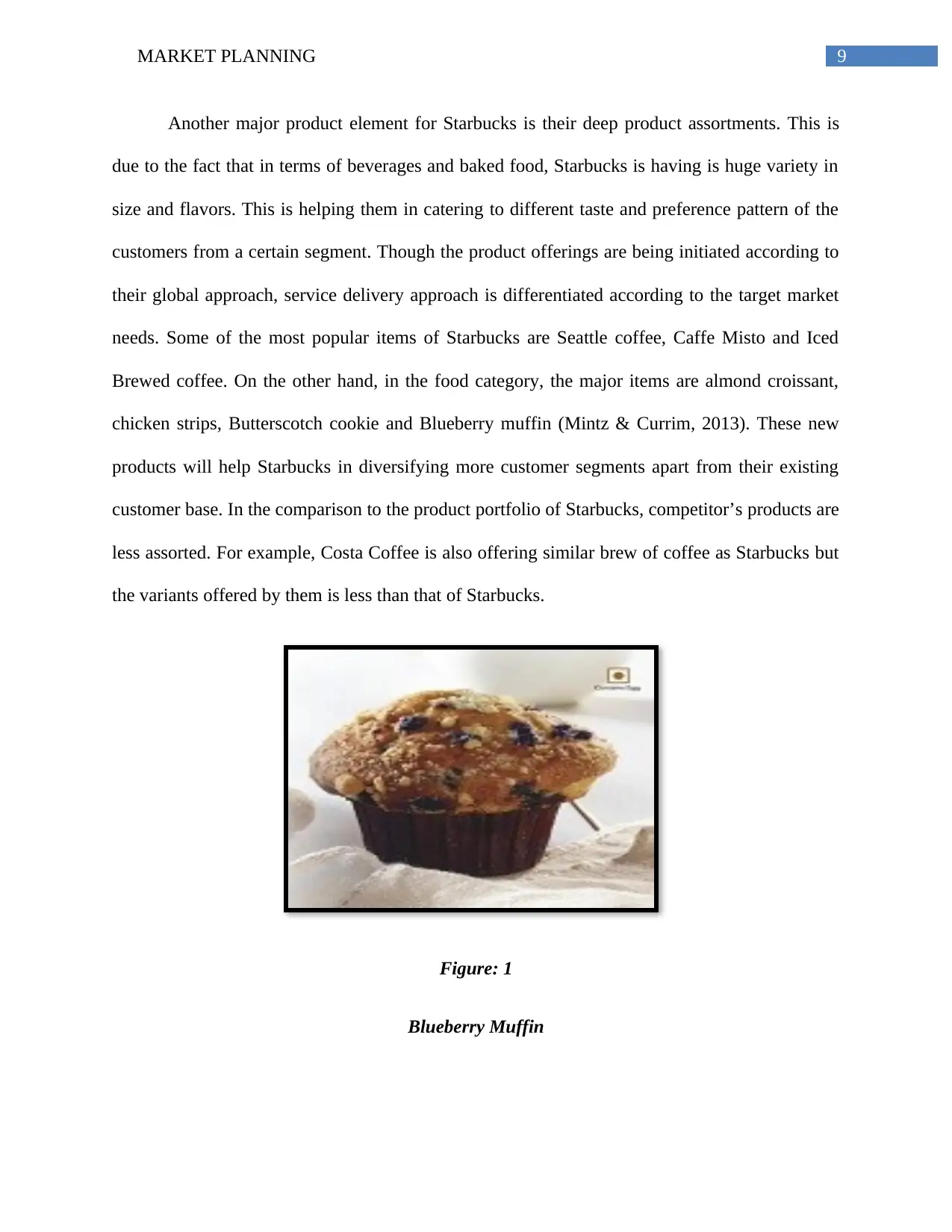
9MARKET PLANNING
Another major product element for Starbucks is their deep product assortments. This is
due to the fact that in terms of beverages and baked food, Starbucks is having is huge variety in
size and flavors. This is helping them in catering to different taste and preference pattern of the
customers from a certain segment. Though the product offerings are being initiated according to
their global approach, service delivery approach is differentiated according to the target market
needs. Some of the most popular items of Starbucks are Seattle coffee, Caffe Misto and Iced
Brewed coffee. On the other hand, in the food category, the major items are almond croissant,
chicken strips, Butterscotch cookie and Blueberry muffin (Mintz & Currim, 2013). These new
products will help Starbucks in diversifying more customer segments apart from their existing
customer base. In the comparison to the product portfolio of Starbucks, competitor’s products are
less assorted. For example, Costa Coffee is also offering similar brew of coffee as Starbucks but
the variants offered by them is less than that of Starbucks.
Figure: 1
Blueberry Muffin
Another major product element for Starbucks is their deep product assortments. This is
due to the fact that in terms of beverages and baked food, Starbucks is having is huge variety in
size and flavors. This is helping them in catering to different taste and preference pattern of the
customers from a certain segment. Though the product offerings are being initiated according to
their global approach, service delivery approach is differentiated according to the target market
needs. Some of the most popular items of Starbucks are Seattle coffee, Caffe Misto and Iced
Brewed coffee. On the other hand, in the food category, the major items are almond croissant,
chicken strips, Butterscotch cookie and Blueberry muffin (Mintz & Currim, 2013). These new
products will help Starbucks in diversifying more customer segments apart from their existing
customer base. In the comparison to the product portfolio of Starbucks, competitor’s products are
less assorted. For example, Costa Coffee is also offering similar brew of coffee as Starbucks but
the variants offered by them is less than that of Starbucks.
Figure: 1
Blueberry Muffin
Paraphrase This Document
Need a fresh take? Get an instant paraphrase of this document with our AI Paraphraser

10MARKET PLANNING
Figure: 2
Butterscotch cookie
Figure: 3
Almond croissant
Figure: 2
Butterscotch cookie
Figure: 3
Almond croissant

11MARKET PLANNING
Figure: 4
Iced Brewed coffee
Figure: 5
Caffe Misto
Figure: 4
Iced Brewed coffee
Figure: 5
Caffe Misto
⊘ This is a preview!⊘
Do you want full access?
Subscribe today to unlock all pages.

Trusted by 1+ million students worldwide
1 out of 21
Related Documents
Your All-in-One AI-Powered Toolkit for Academic Success.
+13062052269
info@desklib.com
Available 24*7 on WhatsApp / Email
![[object Object]](/_next/static/media/star-bottom.7253800d.svg)
Unlock your academic potential
Copyright © 2020–2025 A2Z Services. All Rights Reserved. Developed and managed by ZUCOL.





